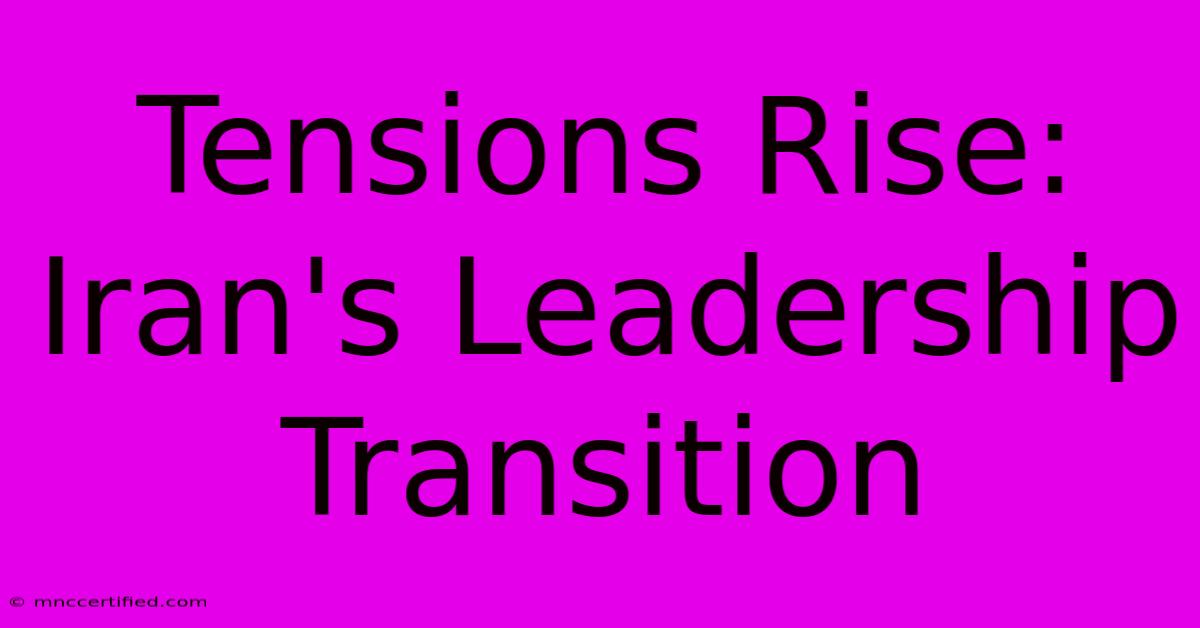Tensions Rise: Iran's Leadership Transition

Table of Contents
Tensions Rise: Iran's Leadership Transition – A Potential Flashpoint?
Iran, a nation steeped in history and currently grappling with significant internal and external pressures, is facing a crucial period: a leadership transition. While not an immediate crisis, the potential for heightened tensions and unforeseen consequences is undeniable. This article delves into the complexities of this transition, analyzing the potential impacts on regional stability and international relations.
Understanding the Stakes: More Than Just a Change of Guard
The upcoming leadership transition in Iran is far more significant than a simple change of personnel. It carries immense implications for the country's domestic policies, its foreign relations, and the broader geopolitical landscape of the Middle East. The Supreme Leader, Ayatollah Ali Khamenei, who has held the ultimate authority for over three decades, is nearing the end of his life. His successor will inherit a nation facing numerous challenges:
- Economic Crisis: Years of sanctions, economic mismanagement, and internal corruption have crippled Iran's economy, leading to widespread public discontent.
- Social Unrest: Frustration over economic hardship, coupled with restrictions on personal freedoms, has fueled sporadic protests and social unrest.
- Nuclear Program: The ongoing negotiations regarding Iran's nuclear program remain a major point of contention with the international community.
- Regional Conflicts: Iran's involvement in regional conflicts, particularly in Syria, Yemen, and Lebanon, has drawn criticism and increased tensions with its neighbors and Western powers.
The Succession Conundrum: A Power Vacuum?
The process of selecting a new Supreme Leader is shrouded in secrecy and involves a complex interplay of religious and political actors. While the Assembly of Experts is formally responsible for choosing the successor, the influence of powerful factions within the Iranian establishment is undeniable. The potential candidates are likely to represent different ideological factions within the ruling clerical establishment, potentially leading to power struggles and internal divisions. This internal competition, however opaque, could exacerbate existing tensions and contribute to instability.
Potential Scenarios and Their Implications:
- A Hardliner Ascending: The selection of a hardline successor could lead to a more confrontational approach towards the West, potentially escalating tensions over the nuclear program and regional conflicts. This scenario could result in increased sanctions and further international isolation.
- A Pragmatist Taking the Reins: Conversely, a more pragmatic leader might seek to de-escalate tensions, potentially engaging in more constructive dialogue with the international community and pursuing economic reforms. This path, however, may face strong resistance from hardline factions within the establishment.
- A Period of Uncertainty: The transition period itself could be characterized by uncertainty and instability, leaving a power vacuum that could be exploited by internal factions or external actors.
International Implications: Ripple Effects Across the Globe
Iran's leadership transition is not an isolated event. It has the potential to trigger significant ripple effects across the globe. Regional stability in the Middle East could be severely impacted, particularly given Iran's influence on various armed groups and its role in regional conflicts. International efforts to contain Iran's nuclear ambitions could be further complicated, depending on the nature of the new leadership. The global oil market could also experience volatility during this period of uncertainty.
Monitoring the Situation: A Crucial Watch
The upcoming leadership transition in Iran demands close monitoring. The international community needs to adopt a cautious yet proactive approach, focusing on diplomatic engagement while remaining prepared for potential escalation. Understanding the intricacies of Iran's internal politics and anticipating the various scenarios are crucial steps toward mitigating risks and promoting stability in a volatile region. The success of navigating this transition will have profound consequences for the Middle East and the global order.
Keywords: Iran leadership transition, Supreme Leader, Ayatollah Khamenei, Iran succession, Middle East politics, regional stability, international relations, Iran nuclear program, economic sanctions, social unrest, geopolitical implications, hardliners, pragmatists.

Thank you for visiting our website wich cover about Tensions Rise: Iran's Leadership Transition. We hope the information provided has been useful to you. Feel free to contact us if you have any questions or need further assistance. See you next time and dont miss to bookmark.
Featured Posts
-
Texas Football Live Arkansas Game Updates
Nov 17, 2024
-
November 16 Nba Dfs Best Picks And Advice
Nov 17, 2024
-
Clemson Survives Pitt Final Score And Game Recap
Nov 17, 2024
-
Classic British Film Hugh Grant
Nov 17, 2024
-
Bond For Deed Vs Owner Financing
Nov 17, 2024